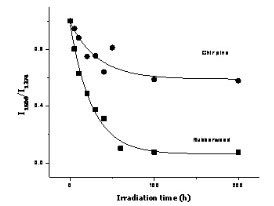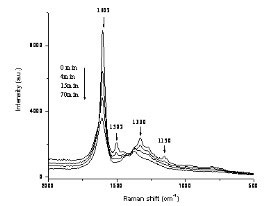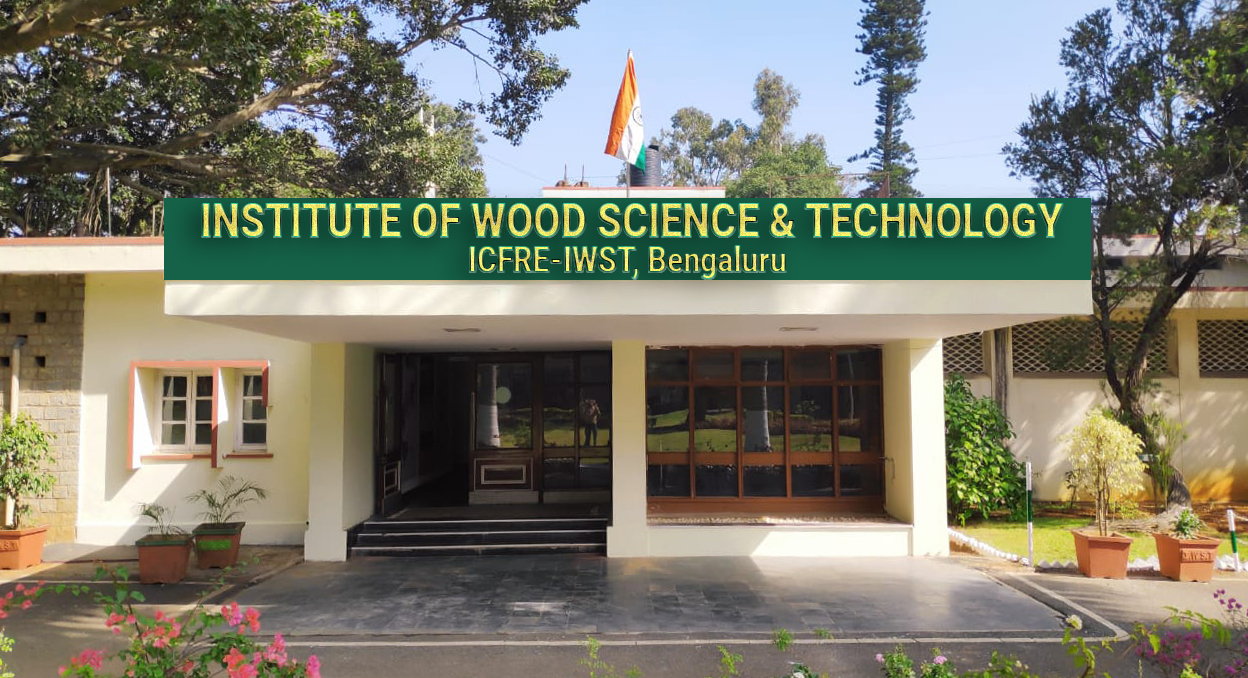Weathering of Wood

Weathering of wood and its protection:
The primary focus of this research is to understand weathering/aging phenomenon in wood under outdoor exposure and developing technologies for preventing such degradation in wood surfaces. This consists of developing treatments which include blocking of ultraviolet light with thin protecting films of UV absorbing materials and blocking of the phenolic lignin structures through chemical modification.
A. Photodegradation of wood

An extensive study of photodegradation of soft and hardwood surfaces has been carried out under artificial accelerated and outdoor natural weathering conditions. FTIR, UV-visible reflectance, UV resonance Raman spectroscopy and fluorescence spectroscopy were used to study chemical changes caused by UV light irradiation. Color changes of wood surfaces were correlated with the degradation of lignin. Effect of presence of extractives on photodegradation has been studied.
Important Publications:
1. K. K. Pandey: Study of effect of photo-irradiation on surface chemistry of wood. Polymer Degradation and Stability, 90 (2005) 9-20.
2. K. K. Pandey: A note on the influence of extractives on the photo-discolouration and photo-degradation of wood. Polymer Degradation and Stability, 87 (2005) 375-379.
B. Photodegradation of wood by UV laser:
The use of UV lasers in place of traditional lamps accelerates the photodegradation of wood surfaces and hence can drastically reduce the exposure duration from hours to minutes. In addition, the wavelength and the energy of laser irradiation can be controlled very precisely. The effect of laser irradiation (Ar+ ion laser, 244 nm) on photodegradation of lignin in hard and softwoods has been investigated by UV resonance Raman (UVRR) spectroscopy. UVRR spectra showed degradation of aromatic structures accompanied by the formation of both ortho- and para-quinone structures as degradation products. The combination of laser irradiation and its subsequent evaluation by UVRR spectroscopy can be a very useful tool for rapid monitoring of the UV degradation of wood and wood products. The monitoring of photodegradation in situ by UVRRS shortens the testing time from days to minutes. (This work was carried out in collaboration with Department of Forest Product Technology, Helsinki University of Technology).
UVRR spectra of rubberwood irradiated with 244 nm frequency doubled Ar+ ion laser. Irradiation durations from top to bottom are 0, 4, 15 and 70 min, respectively.
Important Publications:
1. K.K.Pandey and T. Vuorinen: UV resonance Raman spectroscopic study of photodegradation of hardwood and softwood lignins by UV laser. Holzforschung, 62 (2008) 169-175
2. K.K. Pandey and T. Vuorinen: Comparative study of photodegradation of wood by a UV laser and Xenon light source. Polymer Degradation and Stability , 93 (2008) 2138-2146

C. Weathering of Chemically Modified Wood
Weathering properties of chemically modified wood with a number of reagents viz., epoxides, fatty acid chlorides, isocyanates are being studied. Esterification of wood with benzoyl chloride was found very effective at inhibiting photo-discoloration and photo-stabilizing wood polymers. Wood modification with octanoyl chloride improved dimensional stability and good photostability.
Important Publications:
1. K. K. Pandey and N. Chandrashekhar: Photostability of wood surfaces esterified by benzoyl chloride. J. Applied Polymer Science, 99 (5) (2006) 2367 – 2374.
2. G.K. Prakash, K.K. Pandey, R K.D. Ram and K. M. Mahadevan: Dimensional stability and photostability of octanoylated Wood. Holzforschung, 60 (5) (2006), 539-542.
3. K.K. Pandey and A.J. Pitman: Weathering characteristics of modified rubberwood (Hevea brasiliensis). Journal of Applied Polymer Science, 85 (2002) 622-631

D. Performance of wood Coatings by chemical pretreatments:
Weathering causes chemical and physical changes on wood surface due to photodegradation and weakens subsequently coated paint by developing crack/blister. This results in peeling of film coat and reduction of life span of coated paints. Treatment of wood substrate by ammonical copper chromate and chromic acid solution was observed to prevent above drawbacks effectively.
Pterocarpus marsupium (bijasal) is used in house building construction for door, window frames and other joinery work. They possess considerable amount of water leachable extractives which reduces the quality of paint coatings when in contact with water. Simple brush coat of dilute aqueous solution of chromic acid before any finishing by paint or polish was found to be an effective reagent to check the process of leaching.
Important Publications:
N. K Upreti, K. K. Pandey and A. K. Ananthanarayana: Prevention of extractive leaching by chemical treatments in Pterocarpus marsupium. Holzforschung, 53 (1999) 675 – 676.
K.K. Pandey and N.K Upreti: Role of pretreatments in protection of wood surface and finishes in weathering of Pterocarpus marsupium wood. Journal of Tropical Forest Science, 17(1) (2005) 141-150.
K.K. Pandey and D.P. Khali: Accelerated weathering of wood modified by chromium trioxide. Holzforschung, 52 (1998) 467-471.



